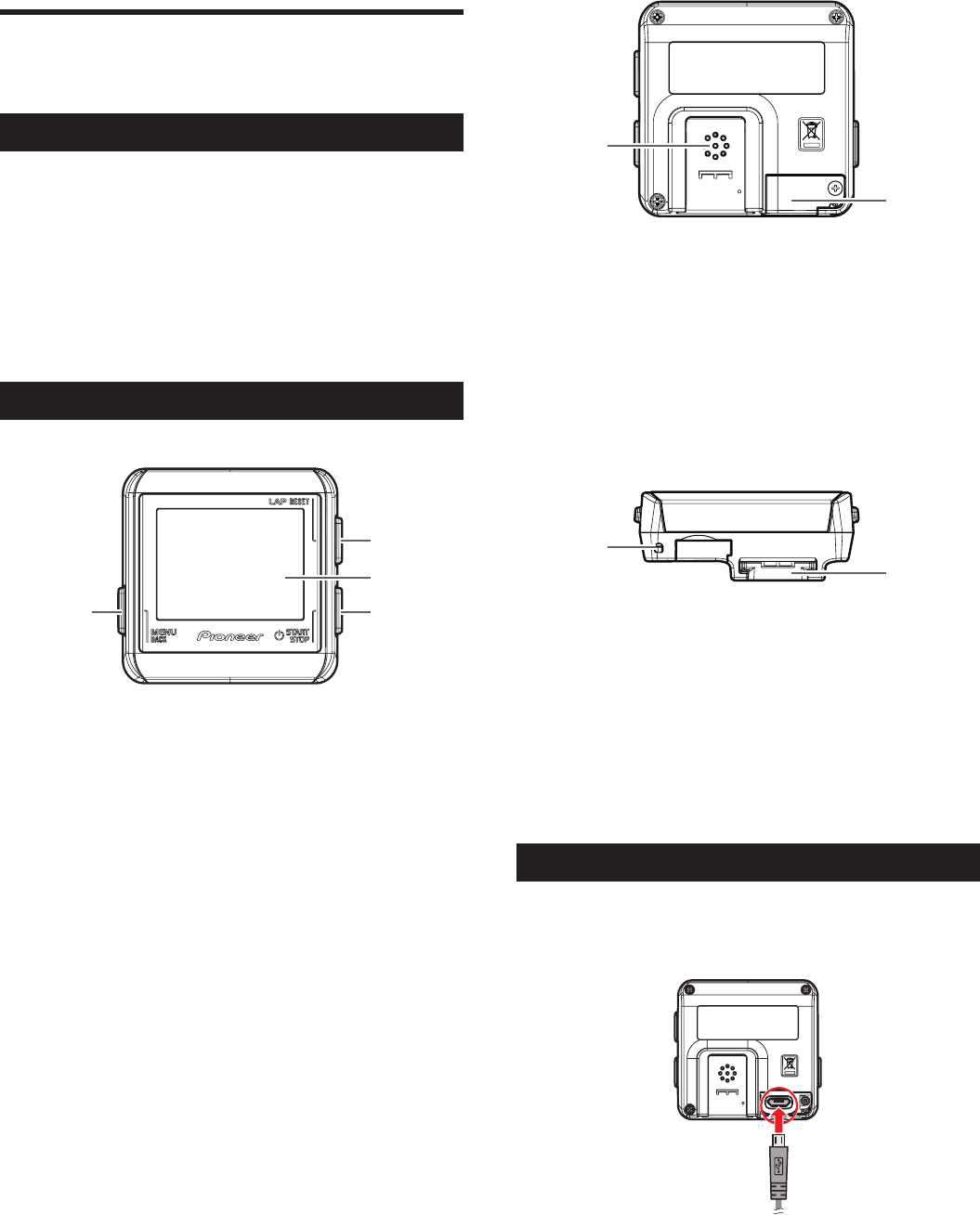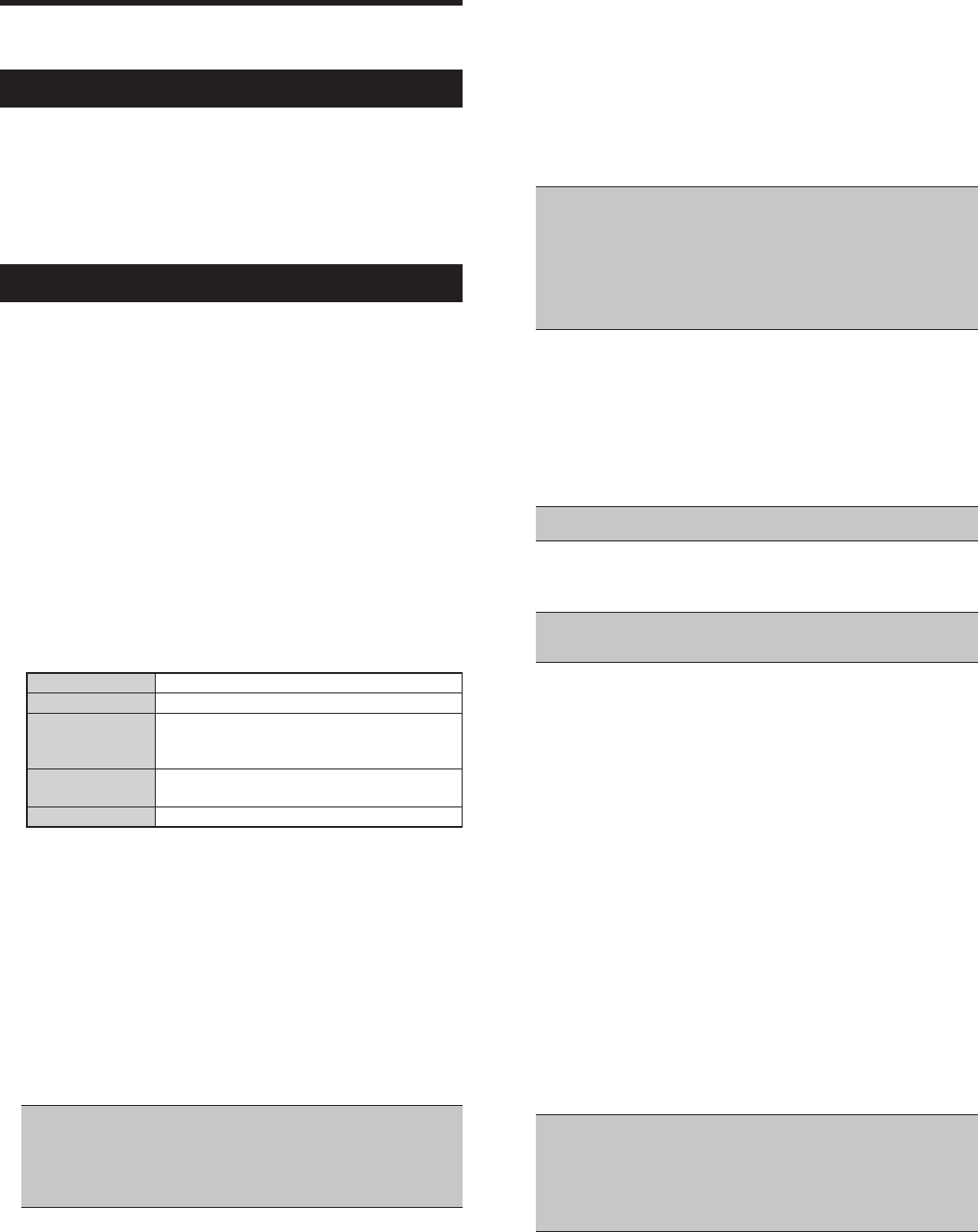User manual

EN
Please read the Important Information for the User in the product
box for product warnings and other important safety information.
Cyclocomputer
SGX-CA500
User's Guide

2
Table of Contents
Introduction ................................................................................................. 3
Getting Started ........................................................................................... 4
Installation .................................................................................................. 5
Basic Operations ......................................................................................... 6
Appendix...................................................................................................... 8

3
Introduction
Features
Trip Data Display (CycloMeter)
Log Function
Update

4
Getting Started
Checking Accessories/Part
Names and Functions
Accessories
Part Names and Functions
Front View
①
②
③④
①[LAP] button
②Display (touch panel)
③[START/STOP] button
④MENU] button
[BACK] button
Back View
⑤
⑥
⑤USB connector cover
USB connector
⑥Speaker
Bottom View
⑦
⑧
⑦Bracket installation slot
⑧Lanyard Hole
Charging
Charging the Device
1. Open the USB connector cover.
2. Connect the provided USB cable to the USB
connector of the device.
3. Turn your PC on and connect the USB cable to
an open USB port on your PC.
The device is turned off

5
To power up
4. Unplug the USB cable from the USB port.
5. Close the USB connector cover.
Checking the Battery Level
Installation
Installation on Your Bike
1. Remove the bolt from the bracket.
2. Make sure that the lever on the bracket is pushed
towards the bolt's direction.
3. Mount the bracket on the handlebar of your bike.
4. Secure the bracket with the bolt.
5. Attach the strap to the device.
6. Attach the device to the bracket.
7. Push back the lever on the bracket to secure the
device to the bracket.
8. Adjust the angle of the device, and then tighten
the bracket.
To detach the device
Installing Sensors

6
Basic Operations
Turning Power On/Off
Turning Power On
1. Press the [START/STOP] button for more than
two seconds.
Power Down
1. Press the [START/STOP] button for more than
two seconds.
Initial Setup
1. Tap [Language] and select a language.
2. Tap [Date & Time] and set the date and the time.
3. Tap [Close].
Pairing Sensors
1. Mount the sensors on your bike.
2. On the home screen, tap the [Sensors] icon.
3. Tap [Connect New].
4. Tap [Device Type] and then select the type of
sensor(s) you wish to pair.
5. Tap [Search].
6. Conr the information from the sensors.
Specifying the device number
1. Check the [Specie Search] check box in the
sensor connection menu.
2. Tap [Device Number].
3. Input the device number and tap [Done].
How to Operate the Touch
Panel
Tap
Swipe
Long touch
Drag

7
Operations List
Scrolling a List
Selecting and Clearing a Check Box
Inputting Text
Using the Keyboard for Input (Alphanumeric and symbol
input)
Selecting Character Types
Inputting Fractions
10-key Pad Input (Numbers)
Dialog Box Input
Editing Text
1. Input characters.
2. Long touch the input box.
3. Tap [Select text].
4. Drag across the characters you want to select.
5. Long touch the input box and then tap [Copy].
6. Tap the input box and move the cursor to the
location where you want to paste the characters.
7. Long touch the input box and then tap [Paste].
Home screen
Viewing the Home Screen and
Performing Home Screen Operations

8
Appendix
Troubleshooting
Will not power up.
The battery is not charged.
The temperature of the device may be too high or low.
The battery goes dead soon after it is charged
or the message "Shutdown" appears and power
turns off when the [START/STOP] button is not
pressed.
The battery charge is low.
The built-in battery is dead.
The screen brightness setting is too high.
The operation button or the touch panel is not
responding.
There are numerous possibilities for non-operation.
The touch panel is not responding.
The touch panel cannot sense your input.
The touch panel is locked.
You do not know how to initialize.
Sensor information is not displayed.
The sensor is not paired.
The sensor battery is almost empty. Or the battery is not
loaded in the sensor correctly.
Cannot pair sensors with the device.
Multiple sensors are activated.
The battery of the sensor is almost empty.Or the battery is
not loaded in the sensor correctly.
The latitude and longitude are not displayed.
Reception is poor when inside a room or in areas
surrounded by mountains.
It may take a few minutes to display the latitude and
longitude when you use the device the rst time.
The Cyclocomputer is not recognized when
connected to a PC.
The Cyclocomputer is not connected correctly to the PC.
Response is different from the location touched
on the touch panel.
The touch panel is not calibrated correctly.
GPS information is not received correctly.
Nearby tall buildings or trees are blocking communication.
Care, Maintenance, and
Storage
Removing the Battery
1. Remove the screw of the device.
2. Remove the back cover of the device and the
lithium-ion battery cable from the substrate.

9
3. Removethelithium-ionbatteryfromtheback
cover.
Remove the tape that holds the lithium-ion battery to
remove the battery.
Be careful not to damage the lithium-ion battery.
[ForAmericanUsers,CanadianUsers]
Follow applicable laws and regulations for transport,
shipping, and disposal of batteries. For details on recycling
the lithium-ion battery, please contact a government
recycling agency, your waste-disposal service, or
visit reputable online recycling sources such as www.
batteryrecycling.com
[Pourlesutilisateursaméricains,utilisateurs
canadiens]
Respectez les législations et réglementations en vigueur
concernant le transport, l’expédition et l’élimination
des batteries. Pour plus de détails concernant le
recyclage des batteries lithium-ion, veuillez contacter
une agence gouvernementale dédiée au recyclage,
votre service d’élimination des déchêts ou visitez les
sources de recyclage en ligne reconnues telles que www.
batteryrecycling.com
Regulatory information
For regulatory identication purposes, your device is assigned
a model number of SGX-CA500.
Marking labels located on the exterior of your device indicate
the regulations that your model complies with. Please
check the marking labels on your device and refer to the
corresponding statements in this section. Some notices apply
to specic models only.
Regulations statements
FCC
FCC ID: AJDK079
Federal Communications Commission (FCC) Statement
You are cautioned that changes or modications not expressly
approved by the part responsible for compliance could void
the user’s authority to operate the equipment.
This equipment has been tested and found to comply with
the limits for a Class B digital device, pursuant to part 15
of the FCC rules. These limits are designed to provide
reasonable protection against harmful interference in a
residential installation. This equipment generates, uses and
can radiate radio frequency energy and, if not installed and
used in accordance with the instructions, may cause harmful
interference to radio communications. However, there is
no guarantee that interference will not occur in a particular
installation. If this equipment does cause harmful interference
to radio or television reception, which can be determined by
turning the equipment off and on, the user is encouraged to
try to correct the interference by one or more of the following
measures:
• Reorient or relocate the receiving antenna.
• Increase the separation between the equipment and
receiver.
• Connect the equipment into an outlet on a circuit different
from that to which the receiver is connected.
• Consult the dealer or an experienced radio/TV technician
for help.
This device complies with Part 15 of the FCC Rules. Operation
is subject to the following two conditions:
1) this device may not cause harmful interference, and
2) this device must accept any interference received, including
interference that may cause undesired operation of the device.
For body worn operation, this device has been tested and
meets FCC RF Exposure guidelines that position the EUT a
minimum of 0 cm from the body.
SAR information: 0.009 W/kg (1g)
IndustryCanada(IC)
IC: 775E-K079
This device complies with Industry Canada licence-exempt
RSS standard(s). Operation is subject to the following two
conditions: (1) this device may not cause interference, and (2)
this devicemust accept any interference, including interference
that may cause undesired operation of the device.
Le présent appareil est conforme aux CNR d'Industrie
Canada applicables aux appareils radio exempts de licence.
L'exploitation est autorisée aux deux conditions suivantes : (1)
l'appareil ne doit pas produire de brouillage, et (2) l'utilisateur
de l'appareil doit accepter tout brouillage radioélectrique subi,
même si le brouillage est susceptible d'en compromettre le
fonctionnement.
CE
Products with the CE marking comply with Radio &
Telecommunication Terminal Equipment Directive (R&TTE)
(1999/5/EC), the Electromagnetic Compatibility Directive
(2004/108/EC) and the Low Voltage Directive (2006/95/EC)
- issued by the Commission of the European Community.
Compliance with these directives implies conformity to the
following European Standards:
EN 301 489-1: Electronic compatibility and Radio spectrum
Matters (ERM), Electromagnetic Compatibility (EMC) standard
for radio equipment and services; Part 1: Common technical
requirements.
EN 301 489-17: Electronic compatibility and Radio spectrum
Matters (ERM), Electromagnetic Compatibility (EMC) standard
for radio equipment and services; Part 17: Specic conditions
for 2.4 GHz wideband transmission systems and 5 GHz high
performance RLAN equipment.
EN 300 328: (Bluetooth) Electromagnetic compatibility and
Radio spectrum Matters (ERM); Wideband Transmission
systems; Data transmission equipment operating in the
2.4 GHz ISM band and using spread spectrum modulation
techniques; Harmonized EN covering essential requirements
under article 3.2 of the R&TTE Directive.
EN 55022: Radio disturbance characteristics
EN 55024: Immunity characteristics
EN 61000-3-2: Limits for harmonic current emissions
EN 61000-3-3: Limitation of voltage uctuation and icker in
low-voltage supply system
EN 62209-2: (SAR) Human exposure to radio frequency elds
from hand-held and body-mounted wireless communication
devices – Human models,instrumentation, and procedures –
Part 2: Procedure to determine the Specic Absorption Rate
(SAR) in the head and body for 30MHz to 6GHz Handheld and
Body-Mounted Devices used in close proximity to the body
IEC 60950-1:2005+A1:2009: Product Safety
The manufacturer cannot be held responsible for modications
made by the User and the consequences thereof, which may
alter the conformity of the product with the CE Marking.

10
Declaration of conformity
Hereby, the manufacturer declares that this SGX-CA500 is in
compliance with the essential requirements and other relevant
provisions of Directive 1999/5/EC.
WEEE
This product must not be disposed of as normal household
waste, in accordance with the EU directive for waste electrical
and electronic equipment (WEEE - 2002/96/EC). Instead, it
should be disposed of by returning it to the point of sale, or to
a municipal recycling collection point.
RCM
The user needs to switch off the device when exposed to
areas with potentially explosive atmospheres such as petrol
stations, chemical storage depots and blasting operations.
Bluetooth
QD ID: xxxxxxx
Safety precautions
Aboutcharging
• Use only the charger supplied with your device. Use of
another type of charger will result in malfunction and/or
danger.
• This product is intended to be supplied by a LISTED Power
Unit marked with “LPS”, “Limited Power Source” and
output rated + 5 V dc / 1.0 A.”
• Use a specied battery in the equipment.
Aboutthecharger
• Do not use the charger in a high moisture environment.
Never touch the charger when your hands or feet are wet.
• Allow adequate ventilation around the charger when using
it to operate the device or charge the battery. Do not cover
the charger with paper or other objects that will reduce
cooling. Do not use the charger while it is inside a carrying
case.
• Connect the charger to a proper power source. The
voltage requirements are found on the product case and/or
packaging.
• Do not use the charger if the cord becomes damaged.
• Do not attempt to service the unit. There are no serviceable
parts inside. Replace the unit if it is damaged or exposed
to excess moisture.
Aboutthebattery
• Use a specied battery in the equipment.
• CAUTION: The battery can burst or explode, releasing
hazardous chemicals. To reduce the risk of re or burns,
do not disassemble, crush, puncture, or dispose of in re
or water.
• Important instructions (for service personnel only)
• Caution: Risk of explosion if battery is replaced by an
incorrect type. Dispose of used batteries according to
the instructions.
• Replace only with the same or equivalent type
recommended by the manufacturer.
• The battery must be recycled or disposed of properly.
• Use the battery only in the specied equipment.
Note
The battery operating time may decrease depending on the
operating conditions.
ANT+ is a wireless personal network protocol with very low
power requirements using the 2.4 GHz frequency band. For
more information, visit http://www.thisisant.com/
Specications and design are subject to possible modications
without notice due to improvement.
Illustrations used in this manual may be different from the
actual device.